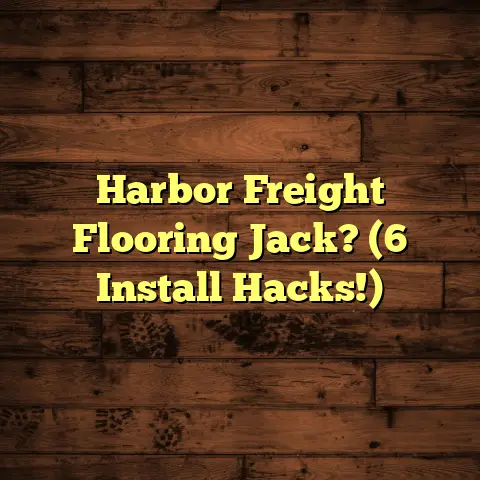Leftover Hardwood? Don’t Waste It! (6 Ideas)
And let me tell you, one of the most common things I see after a flooring job is… leftover hardwood.
It’s practically a universal experience.
You’ve just installed beautiful new floors, stepped back to admire your work, and then BAM!
There it is – a stack of perfectly good planks staring back at you.
It feels wrong to just toss it, right?
Like throwing money away.
I’ve heard it all, from “I overestimated by a mile!” to “We changed our mind about the border.”
One homeowner even joked, “I’m pretty sure I ordered enough to floor the entire neighborhood!”
Whatever the reason, you’re not alone.
But don’t worry, I’m here to help you turn that leftover hardwood from a source of guilt into a source of creativity!
This article will give you six awesome ways to repurpose it.
Let’s dive in and give that wood a second life.
Section 1: Understanding Hardwood Waste
Hardwood flooring – it’s a classic for a reason.
It adds warmth, value, and timeless style to any home.
In fact, according to the National Association of Realtors, hardwood floors are consistently ranked as one of the most appealing features to homebuyers.
But here’s the thing: installing hardwood usually leads to some waste.
Why? Several reasons:
- Overestimation: We often overestimate to avoid running short, which is understandable.
It’s better to have too much than too little, right? - Cutting Mistakes: Even pros like me sometimes make a bad cut.
A slight miscalculation or a wobbly saw can lead to unusable pieces. - Design Changes: Halfway through, you might decide to tweak the pattern, add a border, or change the direction of the planks.
- Irregular Room Shapes: Rooms with lots of angles and corners inevitably lead to more cuts and, therefore, more waste.
The U.S.
Environmental Protection Agency (EPA) estimates that construction and demolition debris accounts for a significant portion of landfill waste.
And while hardwood is a natural material, simply tossing it contributes to that problem.
Think about the resources that went into growing, harvesting, milling, and transporting that wood.
Repurposing leftover hardwood is a win-win.
You reduce waste, save money, and get to unleash your inner DIYer!
Section 2: Creative Idea 1 – DIY Home Décor
Okay, let’s get those creative juices flowing!
My first idea is to transform your leftover hardwood into unique home décor.
Think picture frames, wall art, or decorative shelves.
These projects are relatively simple.
They are a great way to start if you’re new to woodworking.
Picture Frames:
- Materials: Hardwood scraps, saw, miter box (optional but helpful), wood glue, sandpaper, clamps, picture hanging hardware.
- Steps:
- Measure and cut the hardwood into four pieces, creating the frame’s sides.
Use a miter box for clean, angled corners. - Apply wood glue to the corners and clamp them together until dry.
- Sand the frame smooth and add a finish (stain, paint, or varnish).
- Attach picture hanging hardware to the back.
- Measure and cut the hardwood into four pieces, creating the frame’s sides.
Wall Art:
- Materials: Hardwood scraps, saw, sandpaper, wood glue, paint or stain, stencils (optional).
- Steps:
- Cut the hardwood into various shapes and sizes.
- Sand the edges smooth.
- Arrange the pieces into a design and glue them together.
- Paint, stain, or stencil a design onto the wood.
Decorative Shelves:
- Materials: Hardwood scraps, saw, sandpaper, wood glue, shelf brackets.
- Steps:
- Cut the hardwood to the desired shelf size.
- Sand the edges smooth.
- Attach shelf brackets to the wall and then secure the shelf to the brackets.
Style Tips:
- Rustic: Embrace the natural grain and imperfections of the wood.
Use a stain to enhance the wood’s character. - Modern: Paint the wood in bold colors or geometric patterns.
- Farmhouse: Use distressed paint techniques and add metal accents.
I’ve seen some really cool projects using this idea.
One homeowner created a gallery wall using different sizes and finishes of hardwood scraps.
It looked amazing!
Section 3: Creative Idea 2 – Furniture Projects
Ready to step it up a notch?
Let’s talk furniture!
Building small furniture pieces or accents from leftover hardwood is totally doable.
A coffee table, side table, or even a small bench can add a unique touch to your home.
Coffee Table:
- Materials: Hardwood planks, saw, drill, screws, sandpaper, wood glue, table legs (metal or wood).
- Steps:
- Cut the hardwood planks to the desired size for the tabletop.
- Glue and screw the planks together to create a solid surface.
- Sand the tabletop smooth.
- Attach the table legs using screws.
- Apply a finish to protect the wood.
Side Table:
- Materials: Hardwood planks, saw, drill, screws, sandpaper, wood glue.
- Steps:
- Cut the hardwood planks for the tabletop and legs.
- Assemble the legs and attach them to the tabletop using screws and glue.
- Sand the table smooth.
- Apply a finish to protect the wood.
Bench:
- Materials: Hardwood planks, saw, drill, screws, sandpaper, wood glue.
- Steps:
- Cut the hardwood planks for the seat and legs.
- Assemble the legs and attach them to the seat using screws and glue.
- Sand the bench smooth.
- Apply a finish to protect the wood.
Tools You’ll Need:
- Saw (circular saw or hand saw)
- Drill
- Screws
- Sandpaper
- Wood glue
- Clamps
Design Inspiration:
- Mid-Century Modern: Use clean lines and tapered legs.
- Industrial: Combine hardwood with metal accents and exposed hardware.
- Bohemian: Add colorful paint or mosaic details.
I remember helping a client build a small bench for their entryway using leftover oak flooring.
They were so proud of it, and it looked fantastic!
Section 4: Creative Idea 3 – Outdoor Enhancements
Don’t limit yourself to indoor projects!
Leftover hardwood can be used to create some awesome outdoor enhancements.
Think garden planters, birdhouses, or even small patio furniture.
Garden Planters:
- Materials: Hardwood planks, saw, drill, screws, landscape fabric, soil.
- Steps:
- Cut the hardwood planks to the desired size for the planter box.
- Assemble the box using screws.
- Line the inside with landscape fabric to prevent soil erosion.
- Fill with soil and plant your flowers or herbs.
Birdhouses:
- Materials: Hardwood scraps, saw, drill, screws, sandpaper.
- Steps:
- Cut the hardwood into the necessary shapes for the birdhouse.
- Assemble the birdhouse using screws.
- Drill an entrance hole.
- Sand the birdhouse smooth.
- (Optional) Paint or stain the birdhouse.
Patio Furniture (Small Scale):
- Materials: Hardwood planks, saw, drill, screws, sandpaper, outdoor sealant.
- Steps:
- Design and cut the hardwood planks for small chairs or side tables.
- Assemble the furniture using screws.
- Sand the furniture smooth.
- Apply an outdoor sealant to protect the wood from the elements.
Treating Hardwood for Outdoor Use:
- Choose the Right Wood: Some hardwoods, like teak and cedar, are naturally more resistant to rot and insects.
- Apply a Sealant: Use a high-quality outdoor sealant to protect the wood from moisture.
- Regular Maintenance: Reapply sealant every year or two to keep the wood protected.
I once built a set of small Adirondack chairs from leftover ipe hardwood.
They looked amazing on my patio!
Section 5: Creative Idea 4 – Pet Accessories
Okay, pet lovers, this one’s for you!
Your leftover hardwood can be transformed into some pretty cool pet accessories.
Think pet beds, feeding stations, or even toys.
Pet Beds:
- Materials: Hardwood planks, saw, drill, screws, sandpaper, fabric, stuffing.
- Steps:
- Build a frame for the bed using the hardwood planks.
- Sand the frame smooth.
- Create a cushion using fabric and stuffing.
- Place the cushion inside the frame.
Feeding Stations:
- Materials: Hardwood planks, saw, drill, screws, sandpaper, stainless steel bowls.
- Steps:
- Build a platform for the feeding station using the hardwood planks.
- Cut holes in the platform to hold the stainless steel bowls.
- Sand the platform smooth.
Toys:
- Materials: Hardwood scraps, saw, sandpaper, non-toxic finish.
- Steps:
- Cut the hardwood into various shapes and sizes for toys.
- Sand the edges smooth.
- Apply a non-toxic finish to protect the wood.
Safety First!
- Use Non-Toxic Finishes: Make sure any finishes you use are safe for pets.
- Smooth Edges: Sand all edges to prevent splinters.
- Avoid Small Parts: Don’t use small parts that could be a choking hazard.
I built my cat, Whiskers, a little hardwood scratching post.
He loves it!
Section 6: Creative Idea 5 – Storage Solutions
Let’s get practical!
Leftover hardwood is perfect for creating storage solutions.
Shelves, cabinets, or organizers can help you declutter your home and get organized.
Shelves:
- Materials: Hardwood planks, saw, sandpaper, shelf brackets.
- Steps:
- Cut the hardwood to the desired shelf size.
- Sand the edges smooth.
- Attach shelf brackets to the wall and then secure the shelf to the brackets.
Cabinets:
- Materials: Hardwood planks, saw, drill, screws, sandpaper, hinges, cabinet door hardware.
- Steps:
- Cut the hardwood into the necessary pieces for the cabinet.
- Assemble the cabinet using screws.
- Attach hinges and cabinet door hardware.
- Sand the cabinet smooth.
- (Optional) Paint or stain the cabinet.
Organizers:
- Materials: Hardwood scraps, saw, sandpaper, wood glue.
- Steps:
- Cut the hardwood into various shapes and sizes for organizers.
- Assemble the pieces using wood glue.
- Sand the organizer smooth.
Tips for Effective Storage:
- Maximize Vertical Space: Use tall shelves to make the most of your space.
- Label Everything: Label boxes and containers so you know what’s inside.
- Keep It Accessible: Store frequently used items within easy reach.
I built a small cabinet for my garage using leftover maple flooring.
It’s perfect for storing tools and supplies!
Section 7: Creative Idea 6 – Art and Craft Projects for Kids
Get the kids involved!
Leftover hardwood is a fantastic material for art and craft projects.
Simple projects like building blocks or puzzles can spark creativity and teach kids about repurposing.
Building Blocks:
- Materials: Hardwood scraps, saw, sandpaper, non-toxic paint.
- Steps:
- Cut the hardwood into various shapes and sizes for blocks.
- Sand the edges smooth.
- Paint the blocks with non-toxic paint.
Puzzles:
- Materials: Hardwood scraps, saw, sandpaper, jigsaw, pencil.
- Steps:
- Draw a puzzle design on the hardwood.
- Cut out the puzzle pieces using a jigsaw.
- Sand the edges smooth.
Other Ideas:
- Wooden Cars: Cut out car shapes and add wheels.
- Picture Frames: Decorate small picture frames with paint and glitter.
- Ornaments: Create holiday ornaments by cutting out shapes and adding paint and glitter.
Enhancing Creativity:
- Encourage Imagination: Let kids come up with their own designs and ideas.
- Provide a Variety of Materials: Offer paint, glitter, glue, and other materials to enhance their projects.
- Make It Fun: Let kids enjoy the process of creating and experimenting.
I remember helping my niece build a set of wooden cars from leftover cherry flooring.
She had a blast painting them and playing with them!
Conclusion
So, there you have it – six awesome ideas for repurposing your leftover hardwood!
From home décor to furniture, outdoor enhancements to pet accessories, storage solutions to kids’ crafts, there’s something for everyone.
Don’t let that valuable material go to waste.
Get creative, have fun, and transform your leftover hardwood into something beautiful and functional.
I hope these ideas have inspired you to tackle your own leftover hardwood challenges.
Remember, with a little imagination and effort, you can turn what could be waste into something truly amazing.
Now, go get building!





